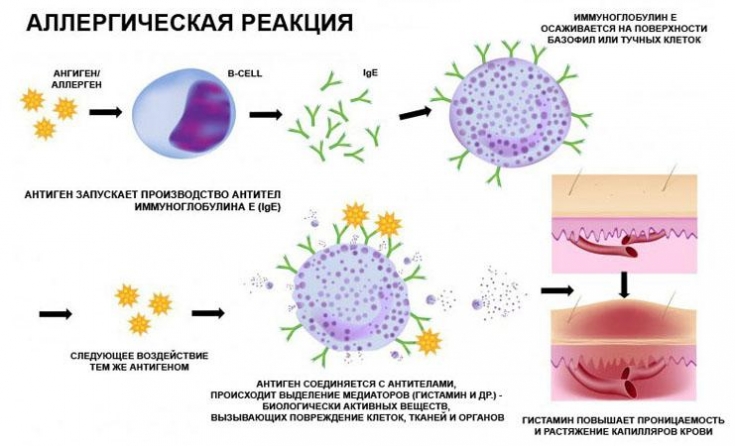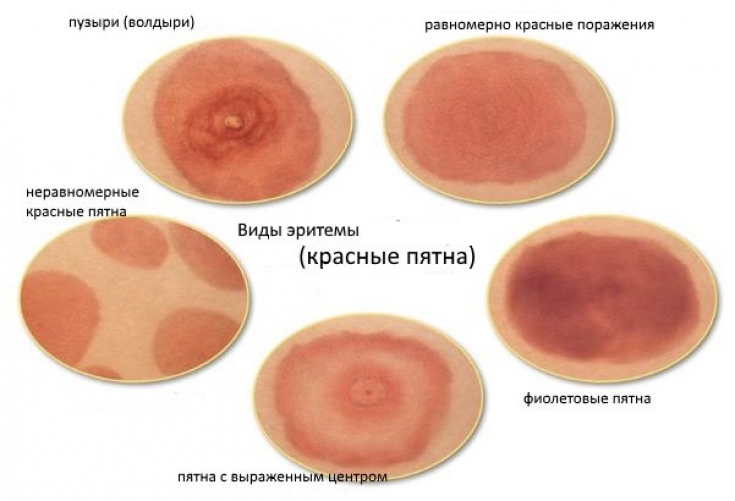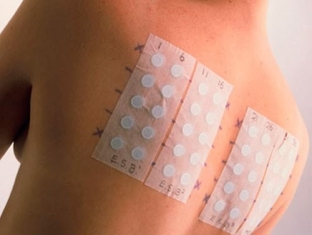Itching, rashes, red spots… And you just washed the dishes with a new detergent. Or put on some new mascara. Or… These "or" there can be many, because allergic dermatitis can be caused by jewelry, and the sun, and plants, and animal hair, and sea water in contact with the skin.
And you can become «spotty» from food, medicines, and even from the air if the allergen is inhaled. Since allergies can have serious consequences, its treatment should not be neglected in any case. About how to recognize the disease in time and get out of the fight against it with minimal losses, tell estet-portal.com.
Causes of allergic spots
Polluted environment, processed foodstuffs, stress, chemicals everywhere: in the soil, in the air, in food, in hygiene products – all this does not benefit our immune system, and it is simply not able to cope with allergens on its own. Yes, and diseases of the internal organs, hormonal disruptions contribute to the occurrence of "spotting".

The main causes of allergic spots:
1. allergic reactions to certain foods, medicines. Allergies are characterized by spots that turn into itchy blisters. To cure, sometimes it is enough to exclude the allergen;
2. infectious diseases (meningitis, chicken pox, measles, rubella, ringworm, syphilis, sometimes typhoid fever) at the initial stage give the following symptoms: itchy rashes in the form of spots on large areas of the body, high temperature. Symptoms similar to allergic spots can give eczema, psoriasis and various dermatitis;
3. diseases of the cardiovascular system. It will not be possible to completely get rid of spots with vegetative disorders;
4. diseases of the nervous system. Allergic spots can become a reaction of the body to stress, strong excitement;
5. malnutrition, abuse of fatty, smoked, spicy, lack of vitamins and minerals can result in spots on the hands, face and stomach.

Symptoms of allergic spots
- skin rash: large patches or redness, which later turn into small blisters with liquid. Bursting, they form weeping wounds, crusts, scales;
- itching;
- temperature increase;
- lacrimation;
- runny nose;
- sometimes cough, vomiting, diarrhea.
Symptoms of allergic spots can be observed from several minutes to several days and even months. First of all, that area of the skin that was in contact with the allergen is affected. But often there are rashes all over the body.
All sizes and colors: types of allergic spots
What are allergic spots? First, any shape, any size and different colors. But most importantly: allergic spots do not protrude above the level of the skin, do not change its density and relief.
- Suddenly appearing (and just as suddenly disappearing in a day), moving around different parts of the body, spots are observed with urticaria.
- Allergic spots all over the body – one of the manifestations of food allergy. In addition, this indicates the neglect of the disease.
- Rash of pink color on open areas of the skin as a reaction to the sun's rays, severe itching, swelling of the skin – this is the symptomatology of photodermatosis.
- Red spots, eventually covered with plaques and silvery scales, the place of their "deployment" those who chose the scalp, elbows, knees - this is psoriasis.
- Pink, elongated oval-shaped eruptions on the chest, arms, abdomen, slightly rising above the surface of the skin – sign of lichen rosacea.
Localization of allergic spots
Allergic patches on the face can be caused by:
- allergens (to cosmetics, food, drugs);
- chemical fumes;
- sunshine, cold;
- toxins produced by intestinal parasites;
- vitamin and mineral deficiency;
- fungal diseases, subcutaneous mites;
- bacterial infections;
- viral, systemic and autoimmune diseases;
- hormonal imbalance;
- problems with the gastrointestinal tract, gallbladder and liver;
- metabolic disorder.
Allergic patches on the neck cause:
- allergens (e.g. in cosmetics);
- rubbing of jewelry, clothes made of synthetic materials;
- food with preservatives and food additives;
- drugs;
- viruses, microbes;
- sweat;
- washing powder in poorly rinsed clothes.
Allergic spots on the hands can provoke:
- malnutrition, especially fatty, fried, spicy, floury, salty, sweet;
- inflammatory processes in the digestive tract;
- allergens (e.g. detergents);
- increased nervous excitability, stress, anxiety;
Allergic patches on the legs can cause:
- allergens present, for example, in poor-quality shoes or foot care products;
- tight shoes;
- fungal infection;
- household chemicals;
- pet hair;
- dust mites;
- internal diseases
Detect the enemy: what are you allergic to
To identify the allergen, you need to simply test. For starters, simple. For example, if allergic spots appear on your face, pay attention to skin care products that you have recently started using, as well as changes in diet.
Discard the new cream and those foods that you suspect. If after a couple of days the condition returned to normal and the allergic spots disappeared, then you have identified the enemy.
But since the reaction of the body to the allergen is sometimes belated, it is not always easy to identify the cause of the appearance of allergic spots and associate them with what you ate, for example, a few days ago. So with any kind of allergic spots, it is better to consult a dermatologist. The doctor will take a medical history and may order allergy tests for you.
They are of the following types:
- skin tests: small scratches are made on the skin of the forearm and drops of allergens are applied. Puffiness, redness will indicate the "hero of the occasion";
- elimination tests: the product suspected of causing allergic spots is excluded from the diet. If after 1-2 weeks the rash completely disappears, the "suspect" goes into the category of "accused";
- study of specific immunoglobulins Ig E: blood is taken from a vein for analysis. This test method is highly sensitive;
- provocative tests: last resort, as these tests are done when a diagnosis has not been made using the methods described above. The test is complex: an allergen is injected into the bronchi, nose, under the tongue of the patient. The reaction is monitored by a doctor. These tests are carried out exclusively in an allergological hospital.

Treatment of allergic spots
The best and most effective treatment for allergic spots caused by an allergen, – exclusion of the source of irritation. Moreover, it is necessary to exclude contact of the allergen with the skin as soon as possible, because the longer this contact, the more difficult and longer the treatment, and dermatitis can turn into eczema.
Topically applied steroid drugs (but only by prescription and after consultation with a doctor!). The form of the drug depends on the type and location of allergic spots. For weeping wounds, it is better to use preparations in the form of aerosols, creams, milk.
For keratinized and flaky surfaces – ointments (for example, Radevit, Traumeel). If allergic spots are localized on the head, it is worth using liquid preparations. In case of concomitant bacterial infection, antibacterial drugs are needed, and sometimes antibiotics.
For almost all types of allergic spots, the doctor prescribes antihistamines (for example, Zirtek, Citrine, Suprastin, Telfact). If necessary – hormonal ointments (for example, Advantan) and herbal medicine. An important part of the treatment is to strengthen the immune system, because a strong body is easier to resist diseases.
Follow a special diet: exclude allergenic foods, add folic acid-containing foods to the menu (cabbage, bell peppers, lettuce, spinach, tomatoes, pears).
If you do not treat allergic spots that do not disappear for a long time, then you can expect such amenities as anaphylactic shock or Quincke's edema.
Prevention Strike: Allergy Spot Prevention
If you have sensitive skin or have already noticed a tendency to allergies, these tips will come in handy for you:
- do housework only with rubber household gloves;
- avoid cheap metal jewelry, avoid skin contact with metal buttons, buckles, clasps, etc.;
- do not wear clothes made of synthetic materials, wool, or dyed fibers – paint can cause irritation;
- do not grow or keep at home plants that can cause allergies (chrysanthemums, tulips, geraniums, poinsettias, philodendrons, etc.);
- use shower gels, pH 5.5 soaps;
- for skin care (both face and body), use milk for sensitive skin, which relieves dryness;
- protect your skin from wind, dry air, frost, sun;
- eliminate allergenic foods (chocolate, strawberries, citrus fruits) from the diet;
- Take vitamins (as agreed with your doctor);
- do not use too hot or too cold water;
- moisten the room regularly;
- when washing clothes, use the "Extra Rinse" function;
- wash bedding more often and change mattresses, pillows, blankets at least once every 8 years;
- Rinse your nose regularly with mild sea salt solution;
- learn relaxation techniques to manage stress;
Take folic acid – a vitamin that helps to increase the body's resistance to allergens.






Add a comment